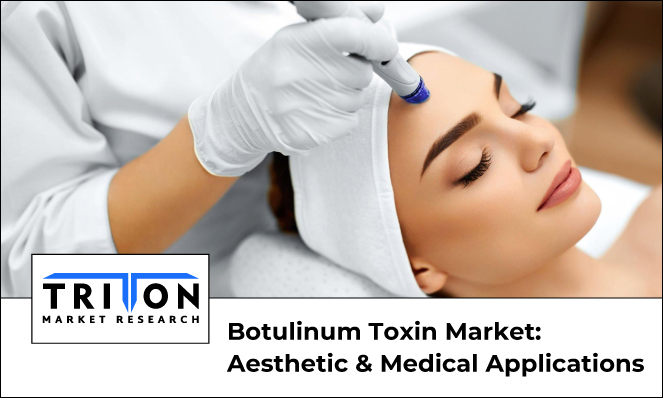



23, August 2023

As noted by the World Health Organization, around 2 billion people are estimated to surpass 60 years of age by 2050. With a yearly growth rate of approximately 3%, the senior demographic is expanding. This shift has spurred a surge in aesthetic and medical procedures. Botulinum toxin has emerged as the most opted-for aesthetic procedure, offering a youthful appearance among an aging population. From cosmetic to medical, its popularity has expanded in recent years. Moreover, it has gained momentum in therapeutic applications, including chronic migraine. Accordingly, Triton’s estimates indicate the global botulinum toxin market to reap revenue worth $12534.31 million by 2030, advancing with a CAGR of 10.17% over 2023-2030.
Additionally, the phenomenon of medical tourism, where individuals from developed nations seek healthcare services in less developed countries, is gaining momentum. The exorbitant costs associated with the US healthcare system, even for those with insurance, drive individuals to explore other options, factoring in price differentials. India stands as an example, where temporary dermal fillers cost approximately $250. This trend is expected to surge due to the advancing healthcare infrastructure, opening avenues for the Asia-Pacific botulinum toxin market.
Globally, cosmetic employment of Botox takes the lead as the most prevalent aesthetic procedure. It boasts a versatile range of aesthetic applications, including treating frown/glabellar lines, forehead lines, and crow’s feet. As per our analysis, in terms of application, forehead lines are set to witness the fastest growth, with a CAGR of 11.30% over the forecast years. Though the FDA’s endorsement for onabotulinumtoxinA is confined to glabellar and forehead lines, other variants like prabotulinumtoxinA exhibit potential for other cosmetic indications.
Botulinum toxin type A leads in term of product type and is expected to continue growth over 2023-2030
Botox Type A, a potent neurotoxin derived from clostridium botulinum bacteria, reigns as one of the most formidable toxins. Growing aging population has elevated its adoption to a large extent. Primarily linked to systemic botulism, Type A injections, including Botox, Dysport, Xeomin, and Jeuveau, dominate cosmetic procedures, targeting facial wrinkles from habitual muscle contractions. The market burgeons with fresh offerings. For instance, in April 2023, FDA approved Galderma’s Sculptra®, an injectable poly-L-lactic acid stimulating natural collagen production to smooth fine lines and smooth wrinkles in the cheek area.
Based on gender, the women category is predicted to register fastest growth at a CAGR of 11.20% during 2023-2030. This surge is steered by the escalating interest of middle-aged women in skin rejuvenation, coupled with a notable uptick in cosmetic surgery rates. According to the Aesthetic Society, approximately 4.1 million women underwent botox procedures in 2020. This inclination is anticipated to catalyze the growth of the studied market.
This neurotoxic protein effectively addresses conditions like chronic migraine, spastic disorders, cervical dystonia, and detrusor hyperactivity.
Chronic migraine dominates the medical application segment and is expected to continue this trend with a CAGR of 10.08% over the forecast years.
As revealed by the American Society of Plastic Surgeons, it effectively reduces chronic migraine attacks compared to a placebo. Moreover, as per Migraine Research Foundation (2018) , over 4 million adults endure chronic daily migraine. On this front, OnabotulinumtoxinA (Botox) stands as the sole prophylactic drug for chronic migraine. Increasing awareness has prompted robust R&D, fueling the market’s growth. For instance, in 2020, AbbVie’s Phase 3 ADVANCE trial showcased oral atogepant’s promise against 4-14 monthly migraine days.
Type B: Widely Preferred Product Type
Type B operates differently from Type A, blocking neuromuscular transmission by binding to receptor sites. While research hasn’t shown superiority between the two types regarding efficacy, studies are ongoing to explore Type B’s medical applications. In a Boston Children’s Hospital study (March 2020), genetic engineering introduced key amino acids to Type B, enhancing effectiveness, duration, and reducing side effects. Additionally, Myobloc received US FDA approval for treating chronic sialorrhea in adults, bolstering its market growth prospects.
In recent years, the stigma around cosmetic procedures has diminished, with non-invasive treatments gaining prominence. This is attributed to social media trends and aesthetic technology advancements. European countries like Germany and Italy see a significant share of non-invasive procedures endorsed by campaigns to raise awareness. Advancements in non-invasive cosmetic therapies are further driven by accessibility offering smaller incisions, faster healing, and reduced complications. Consequently, the demand for Botox injections is projected to rise, creating opportunities for the botulinum toxin market in the foreseeable future.
Forehead lines, frown lines, crow’s feet, and square jaw are major aesthetic applications of Botox.
Q2) Which is the worth of botulinum toxin market in Asia-Pacific?The Asia-Pacific market is expected to garner $3045.84 million by 2030, progressing with a CAGR of 10.88%.

Prevalent cases of terrorist attacks in today’s world is increasing the need for severe standards of security for public safety, and the global market for biometric technology scrupulously accommoda..
Prevalent cases of terrorist attacks in today’s world is increasing the need for..